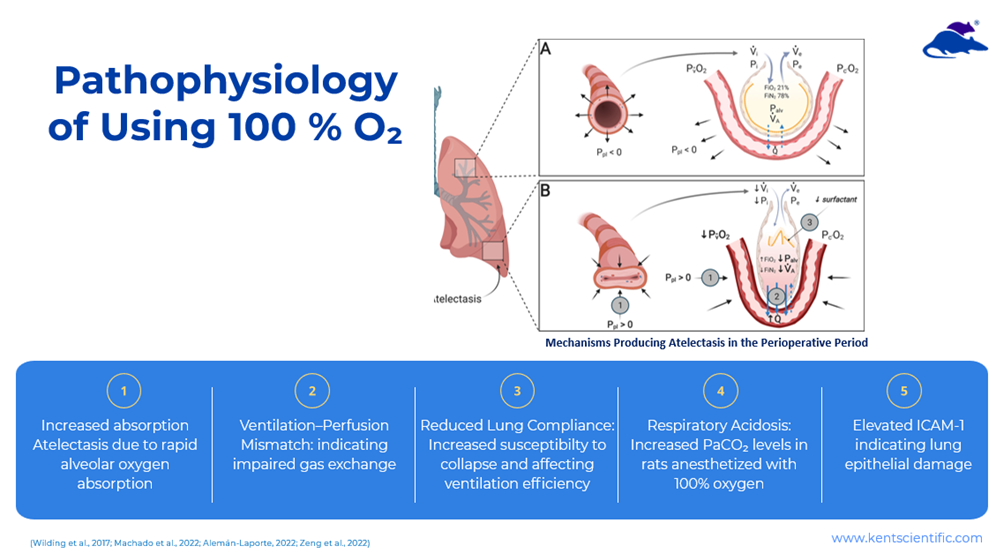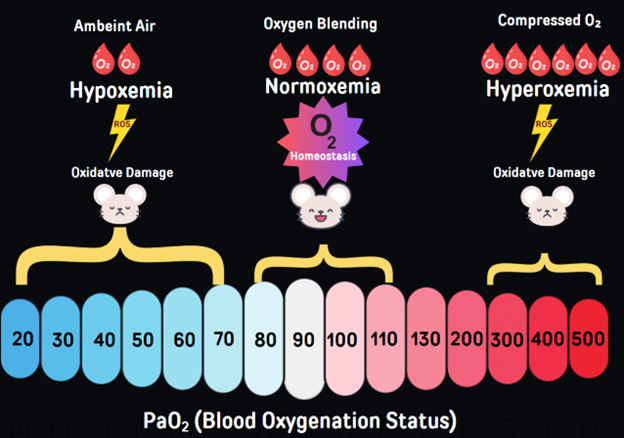Advancing Research Animal Welfare Through Smarter Oxygen Control During Anesthesia
Posted on
How Smart Oxygen Blending Impact Rodent Anesthesia
Rodent research plays a critical role in driving scientific and medical breakthroughs. But along with this responsibility comes another — ensuring that research is conducted ethically, humanely, and in line with the highest standards of animal care.
At the heart of that commitment are the Three Rs: Replace, Reduce, and Refine.
Every protocol, every system, and every decision researchers make should support these principles.
Yet one area that's often overlooked — and could be quietly working against the Three Rs — is how oxygen is delivered during anesthesia as carrier gas.
Historically, managing oxygen levels for rodents during surgery or imaging procedures meant making compromises. You either worked with compressed oxygen, risking hyperoxia and its pathophysiological complications, or tried to rig up cumbersome external mixers to create safer gas blends.

Impact of using 100 % oxygen as anesthetic carrier gas in rodent anesthesia
Neither approach was simple, flexible, or particularly reliable. And when oxygen control is inconsistent, it doesn’t just impact animal welfare — it can undermine data quality and research outcomes, too.
Today, there's a better way: blending ambient air and compressed oxygen directly inside the anesthesia system itself. It sounds simple, but it’s a major leap forward.
This article reviews why oxygen blending is both a technical improvement and a powerful tool for advancing the Three Rs and protecting the integrity of your research.
Refinement: Reducing Stress and Improving Oxygen Homeostasis
Refinement is about minimizing pain, distress, and suffering for research animals wherever possible. It’s not enough to simply meet baseline anesthesia requirements — the goal is to optimize animal welfare every step of the way.
When rodents are exposed to 100% oxygen during anesthesia, they face risks that aren't always obvious during the procedure itself. Hyperoxia — or exposure to excessively high oxygen levels — can lead to oxidative stress, inflammation, lung injury, impaired gas exchange, and even neurological impacts. Even brief periods of Exorbitantly high FiO₂ due to supplementation of 100 % oxygen can induce measurable pathologies and compromise the animal welfare and research data integrity
Blending 100 % oxygen with room air helps researchers fine tune the FiO₂, achieving the perfect balance between optimal oxygenation and preserving true physiological responsiveness. Instead of overwhelming the animal’s physiology with pure oxygen, blending allows for precise control over the inspired oxygen concentration — whether that's 21%, 35%, 50%, 70%, or 100%, depending on the needs of the procedure to maintain the animal under normoxemia reflecting oxygen homeostasis.
By tailoring oxygen delivery to what's actually needed — and avoiding the unnecessary risks of hyperoxia — researchers can significantly reduce post-anesthesia complications, preserving physiological stability, and minimize physiological stress. In other words: better outcomes for the animal, and a cleaner path to high-quality, reproducible data.

Reduction: Getting More From Every Animal
Reduction is about using fewer animals to achieve the same scientific goals — and a big part of that comes down to designing experiments that generate reliable, consistent data the first time.
When oxygen homeostasis during anesthesia aren't tightly controlled, they become another variable in the experiment. Exorbitantly high blood oxygenation levels can introduce noise into imaging data, alter genuine physiological baselines, or cause pathophysiological complications that lead to unanticipated exclusions. All of this increases the risk that animals will need to be re-used, or that additional cohorts will have to be added to achieve statistically valid results.
Smart oxygen blending helps remove that variable. When you know exactly what inspired oxygen levels you're delivering — and when those levels are physiologically appropriate for the species, the procedure, and the equipment — you eliminate a source of error that otherwise might compromise your results.
The better the control over physiological parameters such as oxygen homeostasis during anesthesia, the more reliable the data. The more reliable the data, the fewer animals you need to reach sound scientific conclusions. Precision oxygen blending isn’t just better for the animals — it’s better for the science.
Replacement: Enabling Smarter, More Ethical Research Design
While Replacement — finding alternatives to animal models wherever possible — often feels like a larger systemic challenge, oxygen blending plays a quiet but meaningful role here, too.
First, by improving the welfare and outcomes of animals during critical experiments, researchers strengthen the validity of their data, making it more likely to contribute meaningful insights that move the field forward. High-quality, reproducible data reduces the need for redundant studies and minimizes wasted animal use.
Second, technologies that improve anesthesia precision make it easier to validate in vitro or ex vivo alternatives. If researchers can maintain stable physiological baselines during invasive studies, it becomes easier to correlate findings across different model systems — opening doors for eventual reductions in live animal use.
Finally, a demonstrated commitment to refining and reducing animal use — down to the level of how oxygen is delivered during procedures — reinforces institutional credibility with oversight committees, funding agencies, and the broader scientific community. Every step toward better animal welfare supports the larger goal of eventually replacing live models where appropriate.
A Practical Innovation That Meets Researchers Where They Are
What’s exciting about oxygen blending technology today is that it doesn’t require researchers to overhaul their existing workflows.
Systems like SomnoFlo O2Care integrate the ability to blend room air and compressed oxygen directly inside the anesthesia unit itself.
SpO₂-Guided FiO₂ Titration
SomnoFlo O₂ Care empowers researchers to precisely titrate inspired oxygen concentration (FiO₂) based on SpO₂ feedback, enabling identification of the optimal oxygen percentage required to maintain SpO₂ above 95% during anesthesia. This approach advances precision anesthesia and drives experimental refinement by aligning oxygen delivery with individual physiological needs.
No external mixers.
No custom gas blends.
No cumbersome workarounds.
Researchers can choose the oxygen concentration that best supports the animal’s physiology — at the push of a button — and adjust it dynamically as needed for long procedures, recovery periods, or emergencies. This level of precision used to require expensive, complicated setups. Now it’s built into a simple, reliable platform that fits right into routine research operations.
It’s an easy step forward — but one that carries weight across welfare, compliance, data quality, and institutional reputation.
The Bottom Line
Every decision researchers make — from surgical protocols to environmental enrichment — reflects their commitment to the Three Rs. Oxygen delivery during anesthesia shouldn't be an afterthought. It's a critical opportunity to refine practices, reduce complications, and strengthen scientific integrity.
Blending room air and oxygen isn't just a technical upgrade. It's a smarter, more humane way to support animal welfare, compliance, and research excellence all at once.
And in today’s challenging research environment, that kind of progress is exactly what we need.